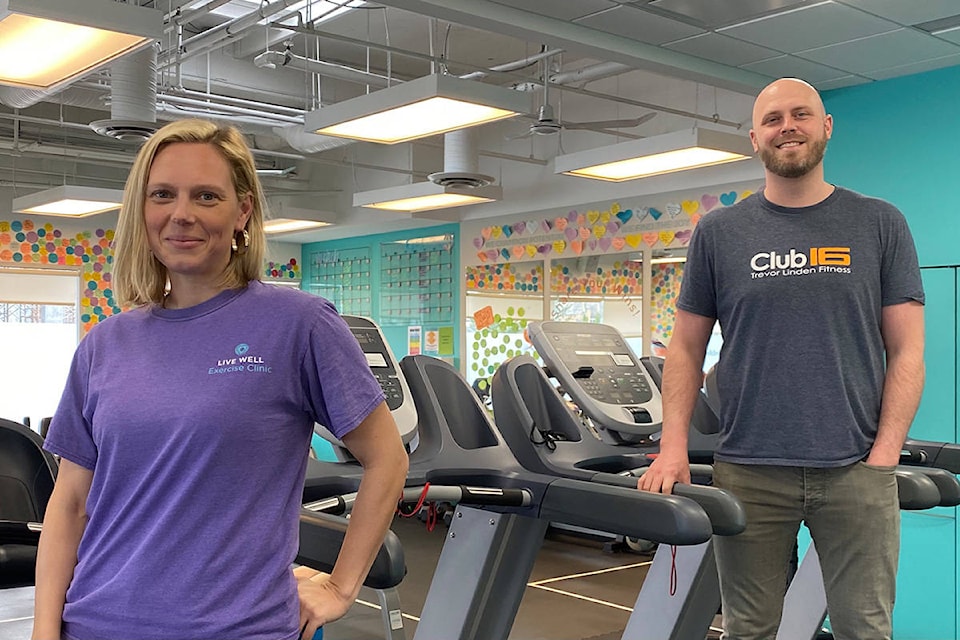A pair of Semiahmoo Peninsula fitness professionals have made a formal request to the federal government to adjust the tax code to not only inspire more Canadians to become physically active, but as a way to help their industry recover in the aftermath of the COVID-19 pandemic.
Backed by more than 100 businesses in the fitness industry, Live Well Exercise Clinic CEO Sara Hodson and Trevor Linden’s Club 16 partner Carl Ulmer, both of the South Surrey and White Rock area, have been gaining traction in their effort to have the federal government adjust the tax system to make gym memberships and services tax-deductible.
While Ulmer said the move has been a request of the fitness industry for some time, the COVID-19 pandemic has raised awareness of the benefits of mental and physical health.
“I think this pandemic really forced the issue and I think that’s why we’re getting a lot of traction on it,” Ulmer said.
At the end of January, Hodson, who co-chairs the BC Fitness Industry Council with Ulmer, had an audience with Deputy Prime Minister Chrystia Freeland. The council has been meeting with provincial health officer Dr. Bonnie Henry’s office over the last six months to support keeping gyms open and safe in the province.
The purpose of the meeting, Hodson said, was for Freeland to learn where the biggest opportunity is for the fitness industry to recover after the pandemic.
SEE ALSO: Live Well Exercise Clinic boss named Surrey’s Business Person of 2017
“Instead of asking for a handout from the government to save our business, we strongly believe the solution is in the hands of the Canadian people,” Hodson told Peace Arch News.
“The best way we can mobilize this is by including fitness memberships and services as a medical expense on our personal taxes, which is line 33099.”
Hodson said in a country where taxes fund education that teaches exercise as a medicine, and funds research that proves the health benefits of exercise, it only makes sense for the government to give Canadians the opportunity to reap even more benefits from physical activity.
“This really isn’t even a political or socioeconomic issue. This is truly a humanity issue,” Hodson said.
Hodson said the deputy prime minister was receptive to the request because it’s highly specific, it’s within a category and infrastructure that already exists, and could have immediate implementation and impact.
Another reason Freeland was receptive, Hodson said, was that the fitness industry employs thousands of young people across the country.
“In the process of (COVID-19), we had to lay off about half of our employees across Canada. As a fitness industry, we had about 150,000 employees coming into the pandemic, now we’re sitting at about 75,000,” Hodson said.
SENIORS HEALTH: Many benefits to starting exercise regime
“(It will) have an impact on employment, it has an impact on the fitness industry, but most importantly, it has an impact on every Canadian’s health.”
Asked why Hodson targeted tax-deduction instead of a more traditional government handout, she said the audience for a handout is “vast and crowded.”
“Not everybody … will be heard,” she said.
“Our financial modelling looks at how can we get about 12 million Canadians more active. What that calculates out to is about $720 million influx into the fitness industry across Canada. We believe that when we trickle that down, that will have an incremental benefit for every single fitness company. This is a long-term play. This is the long-term recovery plan. This isn’t the thing that’s going to save our businesses today or tomorrow.”
What will save fitness businesses, Hodson added, is welcoming communities back into fitness facilities.
“Even though the majority of fitness in British Columbia is open, it’s surprising how much the public is unaware of that and how much the public has a misconception of the safety for fitness facilities,” Hodson said.
“Collaboratively, we have had millions of healthy check-ins with no transmission rates for those people that are part of the Fitness Industry Council of Canada.”
aaron.hinks@peacearchnews.com
Like us on Facebook and follow us on Twitter
